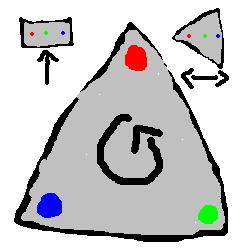While I was in Egypt, I bought a book of letters by Florence Nightingale that she wrote when she was touring about.
Pablo, darling!
Greeting from Thebes; I cam across this, like, totally sweet anecdote; it’s maybe not really your cup of tea (great observer of geometry that you are), but I simply must communicate it to someone or else I will burst!
So, I was walking through the literature souk (on the banks of the nil, oh how very pre-romantic!), and came across a delightful volume of correspondence between Pharoah Rameses the Third and Albrecht Durer (Oh just imagine it! Having your personal letters published for all the world (or it’s literate portion, at any rate) to peruse!), that are curious in several respects.
So, it seems that in this episode with the volume covers, the Pharoah had developed an interest in engravers of the northern-renaissance and, consequently, had decided to write to Durer, secretly hoping to kindle up a relationship so that he might be able to commission some naughty little engravings of tearful clowns or the like from him at a later date.
Albrecht, needless to say, was quite excited at receiving such royal (arguably divine) correspondance, and enclosed with his reply a copy of his recently published treatise on perspective.
Rameses was delighted to receive such a delightful work of science, and studied this book intently
One thing, in particular, that took his attention, was a section illustrating a particularly practical (and rather simple) application of perpspective and projective geometry; he was saying that if you want to write on the side of a building, that it really makes sense to have the letters higher up be smaller than the ones lower down, so that they all appear roughly the same size. This was not rocket-science, nor, indeed, did it involve wheels, but it was remarkable nonetheless, and it was something he could work with. He was something of a trickster, you see, and he thought of an excellent joke to play on Albrecht – not the sort of joke that would be at Durer’s expense, but rather one that he was sure to appreciate.
He thought of a new type of structure – one that would be enormously tall, towering many stories high, and tapering at the top to about half the size of its base: this was the first obelisk. The trick was though, to keep the writing the same size all the way up. Thus, the writing occupies half of the faces lower down, but, as the obelisk narrows upwards, it grows to fill its full width.
And, it seemed, this did indeed win Durer’s eternal affections; he, upon completion of this monument, sent out a convoy to find Durer and bring him to Egypt, without telling him exactly what the reason for this was excepting that it did not involve him being put in to slavery. After a month’s travel, he was arrived in Cairo, the cart stopped directly on front of the obelisk. Nothing, apparently, could exceed his amusement; what delightful humour this Pharaoh had!
And they all, essentially, lived happily ever after. Further collaboration, stretching the notions of perspective to extremes, resulted in the pyramids, designed, in some or hyper-Georgian manner, to seem to be stretching up to infinity.
And, well, it seems like such a delightful story I simply must share it with you.
I heard you have been terribly ill; I will kiss everything better when I get back;
Yours,
xxx
Florence
This got me thinking about a particular chapter of invisible cities, where there is a city whose buildings are built according to the arrangements of the stars, and they keep on adding on more and more stories in the hope that they will some day be able to reach them, and the fact that the pyramids around Giza are laid out to resemble the Orion constellation, that Giza might be an artist’s construction of what such a city might look like if completed.



 ,
,





